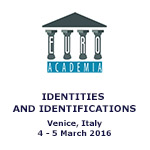Euroacademia Conferences
 Europe Inside-Out: Europe and Europeanness Exposed to Plural Observers (9th Edition) April 24 - 25, 2020
Europe Inside-Out: Europe and Europeanness Exposed to Plural Observers (9th Edition) April 24 - 25, 2020 Identities and Identifications: Politicized Uses of Collective Identities (9th Edition) June 12 - 13, 2020
Identities and Identifications: Politicized Uses of Collective Identities (9th Edition) June 12 - 13, 2020 8th Forum of Critical Studies: Asking Big Questions Again January 24 - 25, 2020
8th Forum of Critical Studies: Asking Big Questions Again January 24 - 25, 2020 Re-Inventing Eastern Europe (7th Edition) December 13 - 14, 2019
Re-Inventing Eastern Europe (7th Edition) December 13 - 14, 2019 The European Union and the Politicization of Europe (8th Edition) October 25 - 26, 2019
The European Union and the Politicization of Europe (8th Edition) October 25 - 26, 2019 Identities and Identifications: Politicized Uses of Collective Identities (8th Edition) June 28 - 29, 2019
Identities and Identifications: Politicized Uses of Collective Identities (8th Edition) June 28 - 29, 2019 The European Union and the Politicization of Europe (7th Edition) January 25 - 26, 2019
The European Union and the Politicization of Europe (7th Edition) January 25 - 26, 2019 7th Forum of Critical Studies: Asking Big Questions Again November 23 - 24, 2018
7th Forum of Critical Studies: Asking Big Questions Again November 23 - 24, 2018 Europe Inside-Out: Europe and Europeanness Exposed to Plural Observers (8th Edition) September 28 - 30, 2018
Europe Inside-Out: Europe and Europeanness Exposed to Plural Observers (8th Edition) September 28 - 30, 2018 Identities and Identifications: Politicized Uses of Collective Identities (7th Edition) June 14 - 15, 2018
Identities and Identifications: Politicized Uses of Collective Identities (7th Edition) June 14 - 15, 2018
The ŁÓDŹ-ORWO Collection: Typographical Identity of Socioeconomic Transition
-
-

-
Presentation speakers
- Jan Kubasiewicz, Massachusetts College of Art and Design, Boston
- Ewa Satalecka, Polish-Japanese Academy of Information Technology, Warsaw, Poland
- Download presentation
Abstract:
The so-called ŁÓDŹ-ORWO Collection refers to a set of two hundred 35-mm slides that document typography and visual communication in the city of Łódź, Poland, in the late 1970s. The set of slides represents a unique study material into the language of visual communication within urban environment during the decade of transition from communism to capitalism in Poland. This recently rediscovered collection has been already the focus of two photography exhibitions authored by Professor Jan Kubasiewicz and prepared to premiere in the USA and Poland in 2016. This paper, conceived together with Professor Ewa Satalecka, provides a rigorous analysis and comparison of typography and visual language documented in the collection. The authors attempt to distinguish different typographical styles, from the “official” government-sponsored propaganda and corporate advertising, to “private” small business visual brands, to “personal” messages within the urban space. The selected images provide the dialogic juxtaposition of the “formal” language of propaganda billboards, mimicking the western-style corporate advertising in the “international typographic style” of the time (predominantly sans serif fonts), with examples imitating western-style signage and branding for small businesses (hand lettering and slab serif fonts), as well as samples of “personal” messages (scripts and graffiti). In addition, the paper discusses instances of visual communication that is unreadable, or barely readable, due to deterioration or physical damage, yet creating unpredictable textual/visual meta-messages. Resulting from rigorous visual studies, the paper concludes in a classification of patterns of typographical identity, as well as the semiotics of typography, contributing to a cultural narrative of that particular historical period of socioeconomic transition in Poland.
-
Related Presentations

Nova Oeiras Neighbourhood Unit to UNESCO Heritage List: A Strong Case of Civic Identity and Intervention
- José Manuel Fernandes














